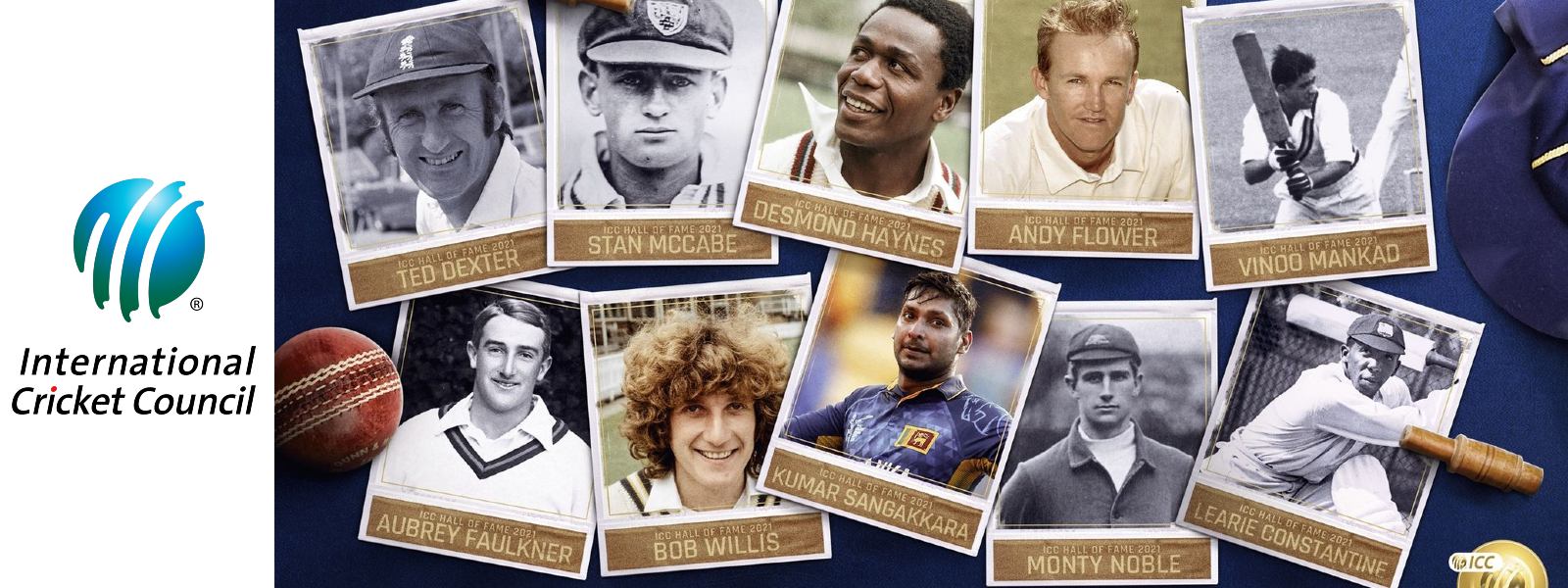.webp)

Kumar Sangakkara inducted into the ICC Hall Of Fame 2021
COLOMBO (News 1st); The great
Kumar Sangakkara
is inducted into the ICC Hall Of Fame 2021, announced the International Cricket Council. Sangakkara is inducted for the MODERN CRICKET ERA, where Players whose greatest contributions to the game were between are between 1996-2015. "Kumar Sangakkara of Sri Lanka played 134 Tests, scored 12,400 runs at 57.40, took 182 catches and 20 stumpings, and was grace personified at the crease. Sangakkara ended his career as the most prolific run-scorer his country had ever known, with double-hundreds flowing from his bat with consummate ease. In 2014 he struck 319 and 105 in the same Test match against Bangladesh and in 2017 fell just 16 runs short of striking six successive centuries in first-class cricket," said the ICC. FULL ICC STATEMENT: The International Cricket Council (ICC) today announced a special edition intake of 10 cricket icons into the ICC Hall of Fame to celebrate the prestigious history of Test cricket, and to coincide with the first ever ICC World Test Championship Final. The 10 legends of the game to be inducted have all made a significant contribution to the history of Test cricket, and join an illustrious list of ICC Hall of Famers, taking the total number to 103 as a result of this intake. The special inductions of the ICC Hall of Fame from the following five eras join the ranks of the world’s greatest players: EARLY CRICKET ERA - Players whose greatest contributions to the game were prior to 1918. Aubrey Faulkner of South Africa played 25 Tests, scored 1,754 runs at 40.79, took 82 wickets at 26.58, and was one of the pioneers of the “googly” at the time. Faulkner was the only man to head both the MRF Tyres ICC Batting and Bowling rankings in Test cricket. He was one of the greatest all-rounders and later one of the best coaches. He was a part of the famous ‘googly quartet’ that so characterised South African cricket in the first decade of the 20th century and he peaked with the bat in the 1910-11 series in Australia when he made 732 runs in the five Tests. Monty Noble of Australia played 42 Tests, scored 1,997 runs at 30.25, took 121 wickets at 25.00, and was one of the greatest Australian all-rounders. He is still the fastest from that country to achieve the 1,000 run / 100 wicket Test double. He played 42 Tests, captaining his side in 15 of them, and he was a trailblazing captain, abandoning mammoth bowling spells to keep bowlers fresh. A true all-rounder, Noble was a banker and a qualified dentist outside of being a prolific cricketer of that time. INTER-WAR ERA - Players whose greatest contributions to the game were from 1918-1945. Sir Learie Constantine of West Indies played 18 Tests, scored 635 runs at 19.24, took 58 wickets at 30.10, and can be considered the first great West Indian all-rounder, playing with a flair and freedom that was decades ahead of his time. He was a champion not only amongst players but for his people too in their political and legal fight against racial discrimination. He was also the first black member of the House of Lords. Stan McCabe of Australia played 39 Tests, scored 2,748 runs at 48.21, took 36 wickets at 42.86, and was a right-handed batsman of the highest class, he played three memorable innings and defied the “Bodyline tactics” that were predominant at the time within the England camp with 187 not out at Sydney. He further struck an unbeaten 189 at Johannesburg in 1935 and then 232 in less than four hours at Nottingham in the 1938 Ashes Test. He was touted as one of the greatest batsmen of the game by his captain Sir Don Bradman. POST-WAR ERA - Players whose greatest contributions to the game were from 1946-1970. Ted Dexter of England played 62 Tests, scored 4,502 runs at 47.89, took 66 wickets at 34.93, and was a superb batsman who combined a firm defence with the ability to destroy any bowling attack off both the front and back foot. His innings of 70 in the 1963 Lord’s Test lives long in the memory of all who saw it. He was an effective partnership breaker with his medium-fast seam bowling and later in life served as England’s Chairman of Selectors and played an influential role in developing what is today’s MRF Tyres ICC Player Rankings. Vinoo Mankad of India played 44 Tests, scored 2,109 runs at 31.47, took 162 wickets at 32.32, and was an opening batsman and slow left arm orthodox bowler, known as one of India’s greatest-ever all-rounders. His most famous feat was against England at Lord's in 1952 when he scored 72 and 184 and bowled 97 overs in the match. He is one of only three cricketers to have batted in every position during his Test career. In later life, he also coached another legendary cricketer and fellow ICC Hall of Fame member from his country, Sunil Gavaskar in Mumbai, India. ODI ERA - Players whose greatest contributions to the game were from 1971-1995. Desmond Haynes of the West Indies played 116 Tests, scored 7,487 runs at 42.29 and was one half of the most prolific opening batting partnership in Test history alongside Gordon Greenidge. He was capable of some destructive innings and combined impeccable timing with power in his stroke making and has played four ICC World Cups in that era. Bob Willis of England played 90 Tests taking 325 wickets at 25.20 and spearheaded the English bowling attack during some of their most memorable moments during this period. Standing two metres tall, he could make the ball bounce awkwardly on most pitches and possessed an excellent yorker and bouncer, both of which he used to great effect over the course of his career. His greatest triumph was the famous eight for 43 that beat Australia at Headingley in 1981 and after retirement became a popular, and often polarising member of the Sky TV commentary box. MODERN CRICKET ERA - Players whose greatest contributions to the game were between 1996-2015. Andy Flower of Zimbabwe played 63 Tests, scoring 4,794 runs at 51.54, took 151 catches with nine stumpings as a left-handed wicket-keeper batsmen. First Zimbabwe player to be inducted in the ICC Hall of Fame. His grit, determination and will to succeed meant at one point he was ranked number 1 batsman in the world. Andy carried his country's batting for long periods, setting the record for the highest Test score by a wicketkeeper with an innings of 232 not out against India at Nagpur in 2000. Later, he became a hugely successful coach, leading England to the number 1 spot in the MRF Tyres ICC Test Rankings for Men. Kumar Sangakkara of Sri Lanka played 134 Tests, scored 12,400 runs at 57.40, took 182 catches and 20 stumpings, and was grace personified at the crease. Sangakkara ended his career as the most prolific run-scorer his country had ever known, with double-hundreds flowing from his bat with consummate ease. In 2014 he struck 319 and 105 in the same Test match against Bangladesh and in 2017 fell just 16 runs short of striking six successive centuries in first-class cricket. The special edition ICC Hall of Fame show was streamed LIVE on ICC digital channels and was hosted by Alan Wilkins. The show featured interviews with some of the inductees and insights from a specialist panel of guests including Lisa Sthalekar and Lawrence Booth of Wisden. Kumar Sangakkara and Andy Flower also made an appearance on the show, giving their reactions to their entry into this league of legends. The 10 icons inducted as part of this special edition were voted for by the ICC Hall of Fame Voting Academy, comprising living Hall of Fame members, a FICA representative, prominent cricket journalists and senior ICC figures. Commenting on getting inducted in the ICC Hall of Fame, Ted Dexter (England) said: “Well I wasn’t completely aware of the ICC Hall of Fame until I found out I was going to be inducted, so after looking at some of the names in it and knowing that cricket deserves to have a Hall of Fame, I was really chuffed to hear the news. The names in the ICC Hall of Fame include some super players, some of whom I played with, against, and some of whom I had a lot to do with when I was working in English cricket. “My fondest memory as a player is probably the New Year’s Ashes Test 1962/63 against the might of Benaud’s Australia. We needed almost 240 to win the match on the final day and boy did I feel good when we got over the line! That is something I will never forget. “After my playing career, not in my wildest dreams did I think I would end up being a top administrator of the game. I thought I would get on with life after playing and build my PR business. Suddenly along came the opportunity to become Chairman of Selectors, and at the time we were expected to beat most of the emerging Test nations. I was aware that time had moved on so unless we thought differently and planned ahead, we were going to be left behind. “There are many moments in my life in cricket of which I am very proud; as a player, an administrator and in establishing what is today’s rankings system. I also take great pride in having simplified the means of producing on-screen captions and scorecards when I was working as a television commentator, something which you take for granted when watching cricket today. My work in cricket is all very gratifying and I am really proud of everything I have achieved. Being recognized by the ICC for what I have achieved is very satisfying and knowing that I’ve been chosen by my peers and so many great names makes me blush, and I’m thrilled along with my family by this honour.” Speaking on his induction, Desmond Haynes said: “I have played Cricket with some of the greats of the game from the West Indies who are also inducted in the ICC Hall of Fame. That team from 1978 till about the 1990s was a fantastic team. As a young boy growing up in Barbados, I never dreamt that I would be one day inducted in the ICC Hall of Fame. I have really come a long way and I am very happy for this honour. The journey was not smooth, I started playing cricket in a little area of St. James in Barbados where I was loved by everyone in the community, who also helped me stay out of trouble. This is also for my grandmother, my mum and my wife, all of whom supported me in my journey.” Speaking on Vinoo Mankad’s induction, fellow ICC Hall of Fame member, Sunil Gavaskar said: “Vinoo Mankad’s legacy has been to tell the aspiring Indian cricketer to believe in oneself. He was a great proponent of self-belief. He was the one who kept saying to me that you need to keep scoring runs and keep at it. When you get a 100, let that be the knock on the selector’s door. If it is unheard, then score that double hundred and let that knock be even louder. You can have the best technique, but if you do not have the temperament to support it you will not succeed, you have to keep hanging in there and have that self-belief. That was the greatest lesson I learnt from him.” Commenting on Bob Willis’s induction into the ICC Hall of Fame, his wife Lauren Clark said: “We are incredibly honoured as a family that Bob is getting inducted in the ICC Hall of Fame and it is sad that he is not here to accept it himself. He deserves to be here; he played 90 Tests for England and took 325 Test wickets and he worked really hard for those wickets, and we are really honoured and proud of him.” Commenting on receiving the ICC Hall of Fame posthumously, granddaughter of Monty Noble, Elizabeth Noble said:“It is a great honour for us as a family to have my grandfather, inducted in the ICC Hall of Fame. We are delighted and truly humbled that his contributions to cricket have been recognized and celebrated in such a way.” Reacting to the honour on her father being inducted in the ICC Hall of Fame posthumously, daughter of Stan McCabe, Christine Hancock said: “I was thrilled when I heard about his induction, and very proud of this honour. He was a good father and we spent a lot of good times together. He was very generous and humble in the family home. He would tell me about his innings at Trent Bridge in 1938 and that while he was batting, Don Bradman told the whole team to go out onto the balcony to watch my father’s innings, telling them they’ll never see anything like it ever again! Although I didn’t see him play a lot myself, I always heard stories about him as this fluid, swashbuckling sort of player. He didn’t talk much about his cricket career at home. He would always rather be known as the father of Geoff and Chris McCabe than as a cricketer.” The ICC Half of Fame special edition induction process: The ICC’s independent statistician compiles a longlist of ex-players or other significant cricketing figures for each era (based on the period during which they had their most significant impact) and these are presented to the Hall of Fame Nominations Committee, together with relevant statistics and brief commentary. The Hall of Fame Nominations Committee subsequently convene to select six names to be shortlisted in each of the five eras noted above. The ICC Hall of Fame Voting Academy, comprising active Hall of Fame members, a FICA representative, prominent cricket journalists and senior ICC figures, vote online to identify their selections for induction in each of the five eras. Results produced a weighted score, against which the top two individuals in each era are inducted into the ICC Hall of Fame. In the event of a tie, the players with the most first choice votes take priority.Other Articles
Featured News





.png )

-785921_550x300.jpg)



-783949_550x300.jpg)


-785316_550x300.jpg)



















.gif)